Project Management Report: Communication, Methodologies Analysis
VerifiedAdded on 2023/01/09
|33
|6282
|29
Report
AI Summary
This report, focusing on project management, begins with an introduction to communication processes, including verbal and non-verbal methods, and their importance in project structures. It emphasizes the application of effective communication strategies, such as downward, upward, and diagonal communication, within a project context to achieve objectives. The report then delves into various project management methodologies, specifically Waterfall, Agile, and PRINCE2, outlining their pros and cons. It concludes by justifying the selection of the Waterfall model for the project, highlighting its suitability for managing requirements, providing structured analysis, and ensuring quality assurance, particularly for smaller projects. The report also includes a Project Initiation Document (PID), Stakeholder Analysis, Critical Path, Work Breakdown Structure (WBS), and a budget table in the appendix, providing a comprehensive overview of the project planning and execution.
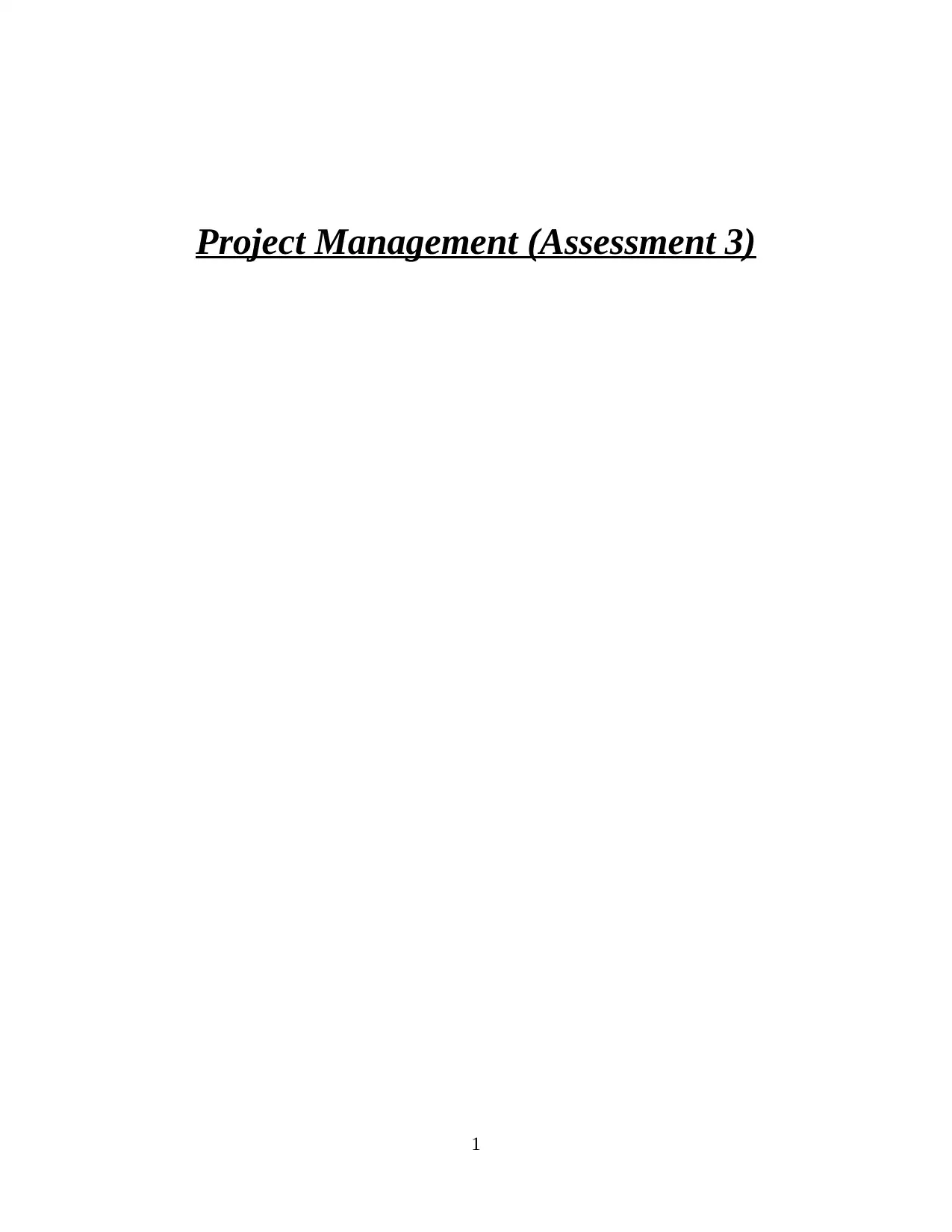
Project Management (Assessment 3)
1
1
Paraphrase This Document
Need a fresh take? Get an instant paraphrase of this document with our AI Paraphraser
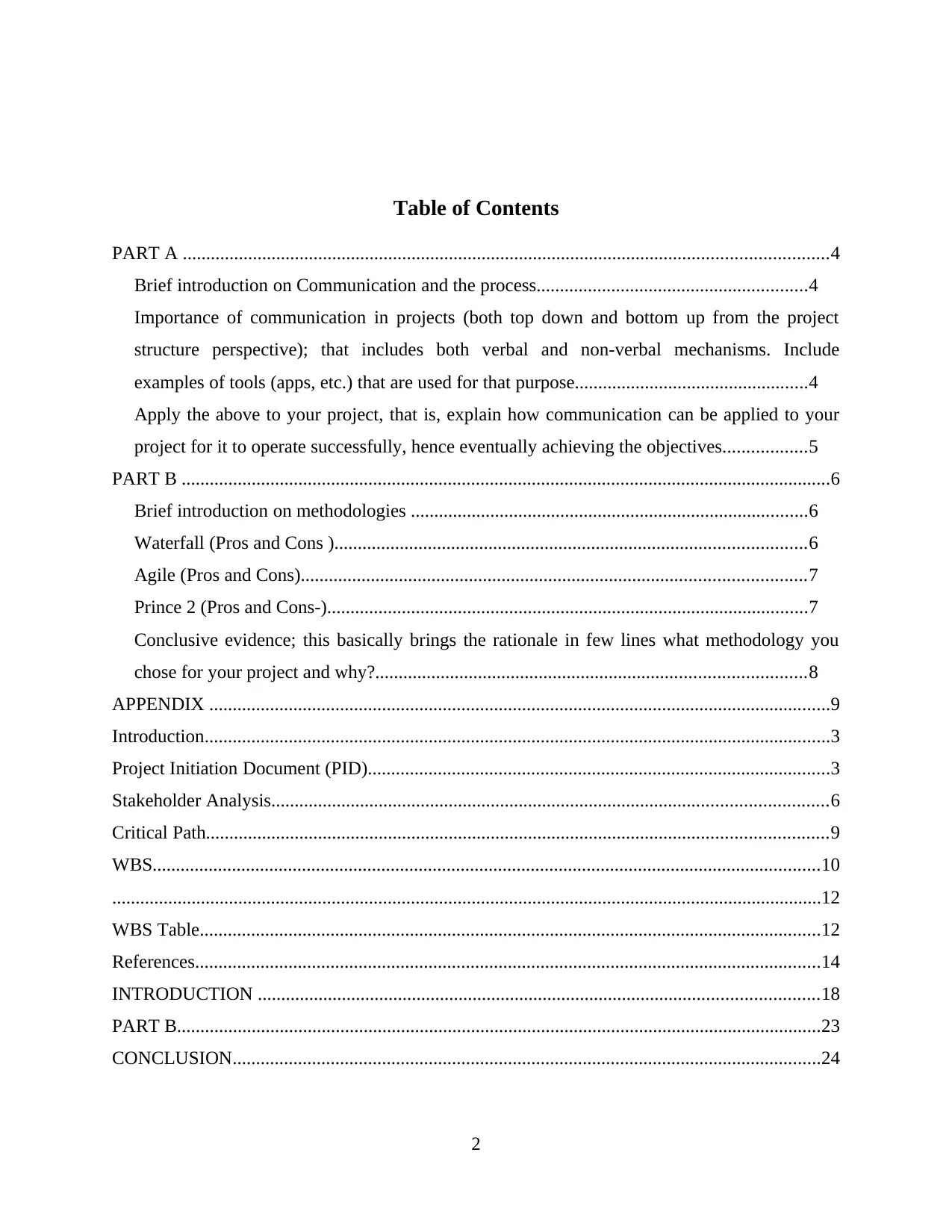
Table of Contents
PART A ..........................................................................................................................................4
Brief introduction on Communication and the process..........................................................4
Importance of communication in projects (both top down and bottom up from the project
structure perspective); that includes both verbal and non-verbal mechanisms. Include
examples of tools (apps, etc.) that are used for that purpose..................................................4
Apply the above to your project, that is, explain how communication can be applied to your
project for it to operate successfully, hence eventually achieving the objectives..................5
PART B ...........................................................................................................................................6
Brief introduction on methodologies .....................................................................................6
Waterfall (Pros and Cons ).....................................................................................................6
Agile (Pros and Cons)............................................................................................................7
Prince 2 (Pros and Cons-).......................................................................................................7
Conclusive evidence; this basically brings the rationale in few lines what methodology you
chose for your project and why?............................................................................................8
APPENDIX .....................................................................................................................................9
Introduction......................................................................................................................................3
Project Initiation Document (PID)...................................................................................................3
Stakeholder Analysis.......................................................................................................................6
Critical Path.....................................................................................................................................9
WBS...............................................................................................................................................10
........................................................................................................................................................12
WBS Table.....................................................................................................................................12
References......................................................................................................................................14
INTRODUCTION ........................................................................................................................18
PART B..........................................................................................................................................23
CONCLUSION..............................................................................................................................24
2
PART A ..........................................................................................................................................4
Brief introduction on Communication and the process..........................................................4
Importance of communication in projects (both top down and bottom up from the project
structure perspective); that includes both verbal and non-verbal mechanisms. Include
examples of tools (apps, etc.) that are used for that purpose..................................................4
Apply the above to your project, that is, explain how communication can be applied to your
project for it to operate successfully, hence eventually achieving the objectives..................5
PART B ...........................................................................................................................................6
Brief introduction on methodologies .....................................................................................6
Waterfall (Pros and Cons ).....................................................................................................6
Agile (Pros and Cons)............................................................................................................7
Prince 2 (Pros and Cons-).......................................................................................................7
Conclusive evidence; this basically brings the rationale in few lines what methodology you
chose for your project and why?............................................................................................8
APPENDIX .....................................................................................................................................9
Introduction......................................................................................................................................3
Project Initiation Document (PID)...................................................................................................3
Stakeholder Analysis.......................................................................................................................6
Critical Path.....................................................................................................................................9
WBS...............................................................................................................................................10
........................................................................................................................................................12
WBS Table.....................................................................................................................................12
References......................................................................................................................................14
INTRODUCTION ........................................................................................................................18
PART B..........................................................................................................................................23
CONCLUSION..............................................................................................................................24
2
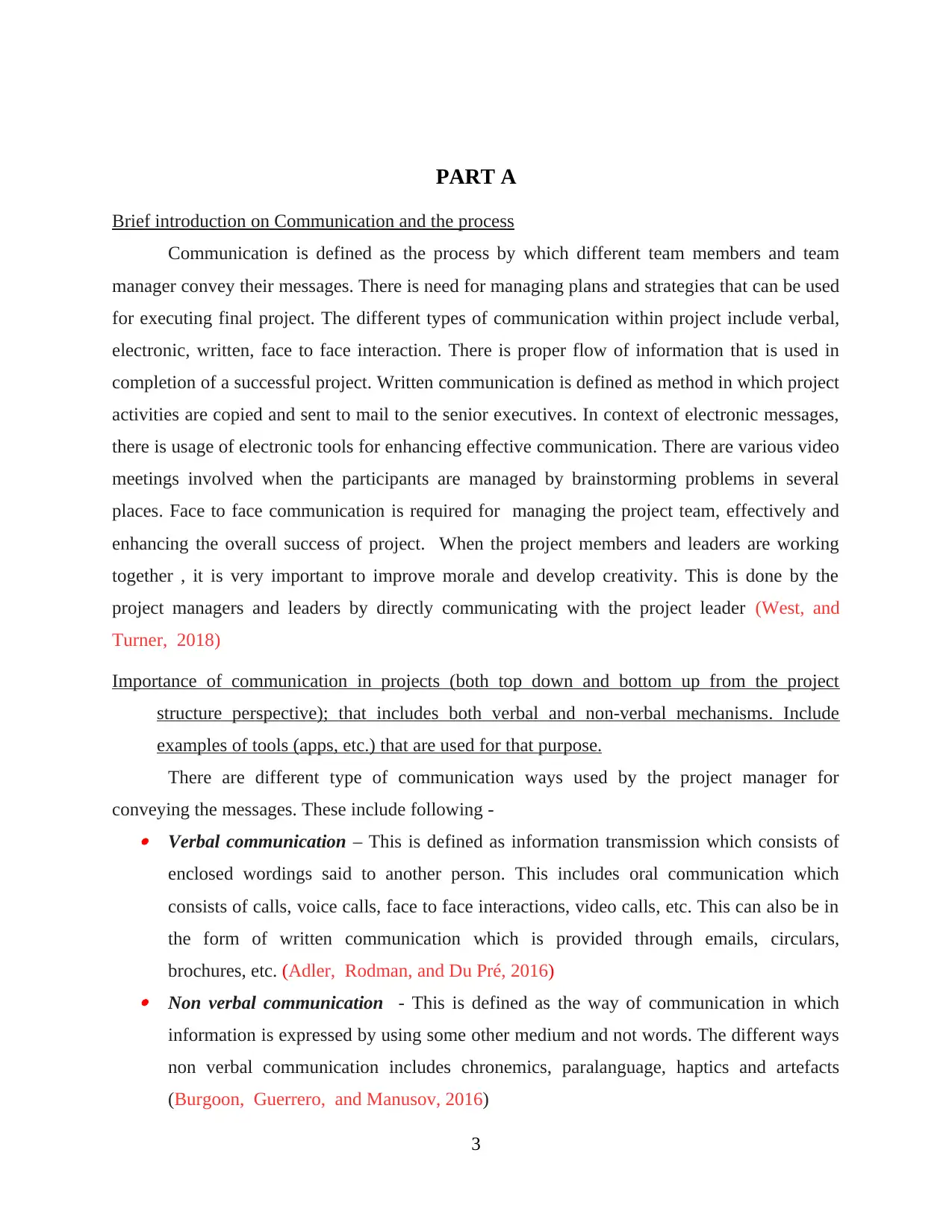
PART A
Brief introduction on Communication and the process
Communication is defined as the process by which different team members and team
manager convey their messages. There is need for managing plans and strategies that can be used
for executing final project. The different types of communication within project include verbal,
electronic, written, face to face interaction. There is proper flow of information that is used in
completion of a successful project. Written communication is defined as method in which project
activities are copied and sent to mail to the senior executives. In context of electronic messages,
there is usage of electronic tools for enhancing effective communication. There are various video
meetings involved when the participants are managed by brainstorming problems in several
places. Face to face communication is required for managing the project team, effectively and
enhancing the overall success of project. When the project members and leaders are working
together , it is very important to improve morale and develop creativity. This is done by the
project managers and leaders by directly communicating with the project leader (West, and
Turner, 2018)
Importance of communication in projects (both top down and bottom up from the project
structure perspective); that includes both verbal and non-verbal mechanisms. Include
examples of tools (apps, etc.) that are used for that purpose.
There are different type of communication ways used by the project manager for
conveying the messages. These include following - Verbal communication – This is defined as information transmission which consists of
enclosed wordings said to another person. This includes oral communication which
consists of calls, voice calls, face to face interactions, video calls, etc. This can also be in
the form of written communication which is provided through emails, circulars,
brochures, etc. (Adler, Rodman, and Du Pré, 2016) Non verbal communication - This is defined as the way of communication in which
information is expressed by using some other medium and not words. The different ways
non verbal communication includes chronemics, paralanguage, haptics and artefacts
(Burgoon, Guerrero, and Manusov, 2016)
3
Brief introduction on Communication and the process
Communication is defined as the process by which different team members and team
manager convey their messages. There is need for managing plans and strategies that can be used
for executing final project. The different types of communication within project include verbal,
electronic, written, face to face interaction. There is proper flow of information that is used in
completion of a successful project. Written communication is defined as method in which project
activities are copied and sent to mail to the senior executives. In context of electronic messages,
there is usage of electronic tools for enhancing effective communication. There are various video
meetings involved when the participants are managed by brainstorming problems in several
places. Face to face communication is required for managing the project team, effectively and
enhancing the overall success of project. When the project members and leaders are working
together , it is very important to improve morale and develop creativity. This is done by the
project managers and leaders by directly communicating with the project leader (West, and
Turner, 2018)
Importance of communication in projects (both top down and bottom up from the project
structure perspective); that includes both verbal and non-verbal mechanisms. Include
examples of tools (apps, etc.) that are used for that purpose.
There are different type of communication ways used by the project manager for
conveying the messages. These include following - Verbal communication – This is defined as information transmission which consists of
enclosed wordings said to another person. This includes oral communication which
consists of calls, voice calls, face to face interactions, video calls, etc. This can also be in
the form of written communication which is provided through emails, circulars,
brochures, etc. (Adler, Rodman, and Du Pré, 2016) Non verbal communication - This is defined as the way of communication in which
information is expressed by using some other medium and not words. The different ways
non verbal communication includes chronemics, paralanguage, haptics and artefacts
(Burgoon, Guerrero, and Manusov, 2016)
3
⊘ This is a preview!⊘
Do you want full access?
Subscribe today to unlock all pages.

Trusted by 1+ million students worldwide
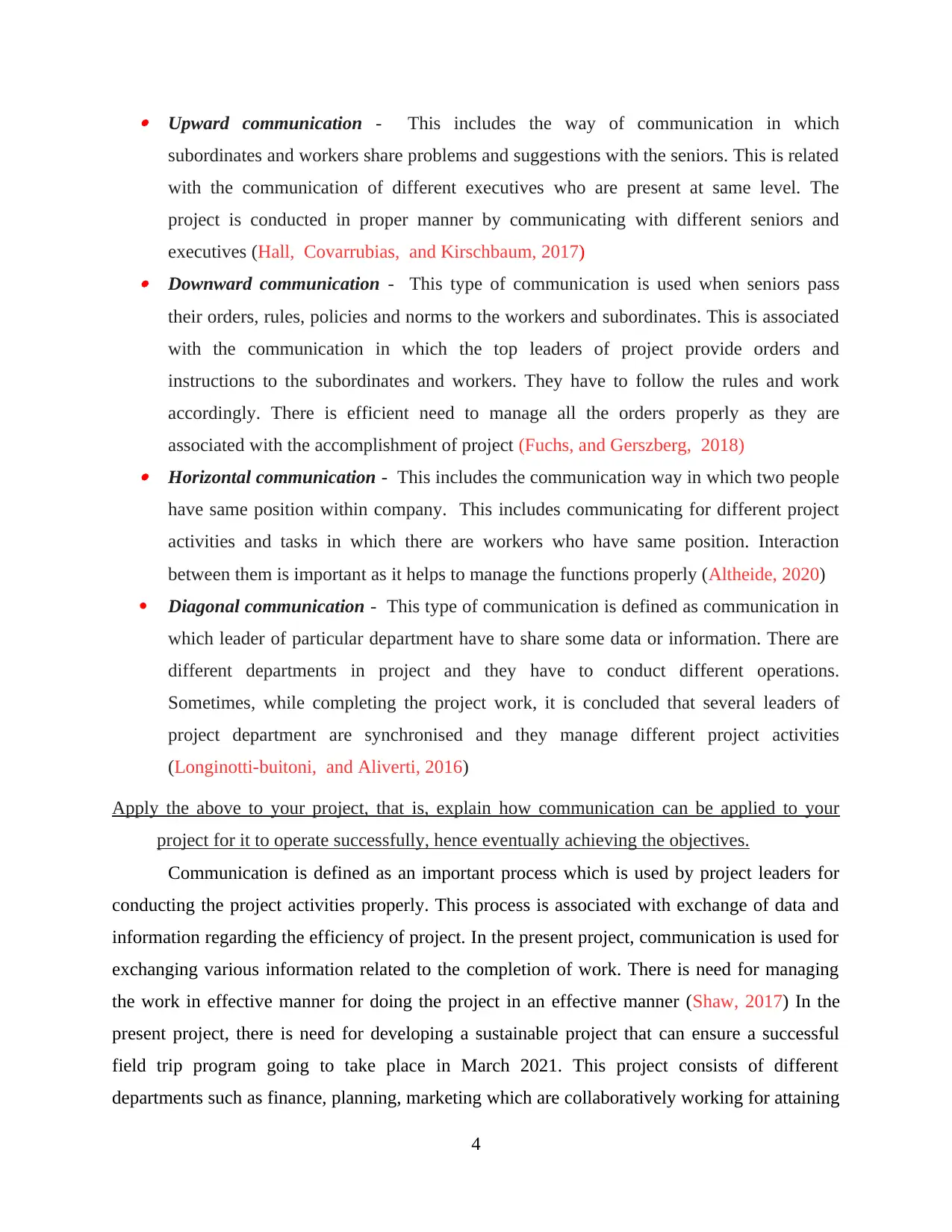
Upward communication - This includes the way of communication in which
subordinates and workers share problems and suggestions with the seniors. This is related
with the communication of different executives who are present at same level. The
project is conducted in proper manner by communicating with different seniors and
executives (Hall, Covarrubias, and Kirschbaum, 2017) Downward communication - This type of communication is used when seniors pass
their orders, rules, policies and norms to the workers and subordinates. This is associated
with the communication in which the top leaders of project provide orders and
instructions to the subordinates and workers. They have to follow the rules and work
accordingly. There is efficient need to manage all the orders properly as they are
associated with the accomplishment of project (Fuchs, and Gerszberg, 2018) Horizontal communication - This includes the communication way in which two people
have same position within company. This includes communicating for different project
activities and tasks in which there are workers who have same position. Interaction
between them is important as it helps to manage the functions properly (Altheide, 2020)
Diagonal communication - This type of communication is defined as communication in
which leader of particular department have to share some data or information. There are
different departments in project and they have to conduct different operations.
Sometimes, while completing the project work, it is concluded that several leaders of
project department are synchronised and they manage different project activities
(Longinotti-buitoni, and Aliverti, 2016)
Apply the above to your project, that is, explain how communication can be applied to your
project for it to operate successfully, hence eventually achieving the objectives.
Communication is defined as an important process which is used by project leaders for
conducting the project activities properly. This process is associated with exchange of data and
information regarding the efficiency of project. In the present project, communication is used for
exchanging various information related to the completion of work. There is need for managing
the work in effective manner for doing the project in an effective manner (Shaw, 2017) In the
present project, there is need for developing a sustainable project that can ensure a successful
field trip program going to take place in March 2021. This project consists of different
departments such as finance, planning, marketing which are collaboratively working for attaining
4
subordinates and workers share problems and suggestions with the seniors. This is related
with the communication of different executives who are present at same level. The
project is conducted in proper manner by communicating with different seniors and
executives (Hall, Covarrubias, and Kirschbaum, 2017) Downward communication - This type of communication is used when seniors pass
their orders, rules, policies and norms to the workers and subordinates. This is associated
with the communication in which the top leaders of project provide orders and
instructions to the subordinates and workers. They have to follow the rules and work
accordingly. There is efficient need to manage all the orders properly as they are
associated with the accomplishment of project (Fuchs, and Gerszberg, 2018) Horizontal communication - This includes the communication way in which two people
have same position within company. This includes communicating for different project
activities and tasks in which there are workers who have same position. Interaction
between them is important as it helps to manage the functions properly (Altheide, 2020)
Diagonal communication - This type of communication is defined as communication in
which leader of particular department have to share some data or information. There are
different departments in project and they have to conduct different operations.
Sometimes, while completing the project work, it is concluded that several leaders of
project department are synchronised and they manage different project activities
(Longinotti-buitoni, and Aliverti, 2016)
Apply the above to your project, that is, explain how communication can be applied to your
project for it to operate successfully, hence eventually achieving the objectives.
Communication is defined as an important process which is used by project leaders for
conducting the project activities properly. This process is associated with exchange of data and
information regarding the efficiency of project. In the present project, communication is used for
exchanging various information related to the completion of work. There is need for managing
the work in effective manner for doing the project in an effective manner (Shaw, 2017) In the
present project, there is need for developing a sustainable project that can ensure a successful
field trip program going to take place in March 2021. This project consists of different
departments such as finance, planning, marketing which are collaboratively working for attaining
4
Paraphrase This Document
Need a fresh take? Get an instant paraphrase of this document with our AI Paraphraser
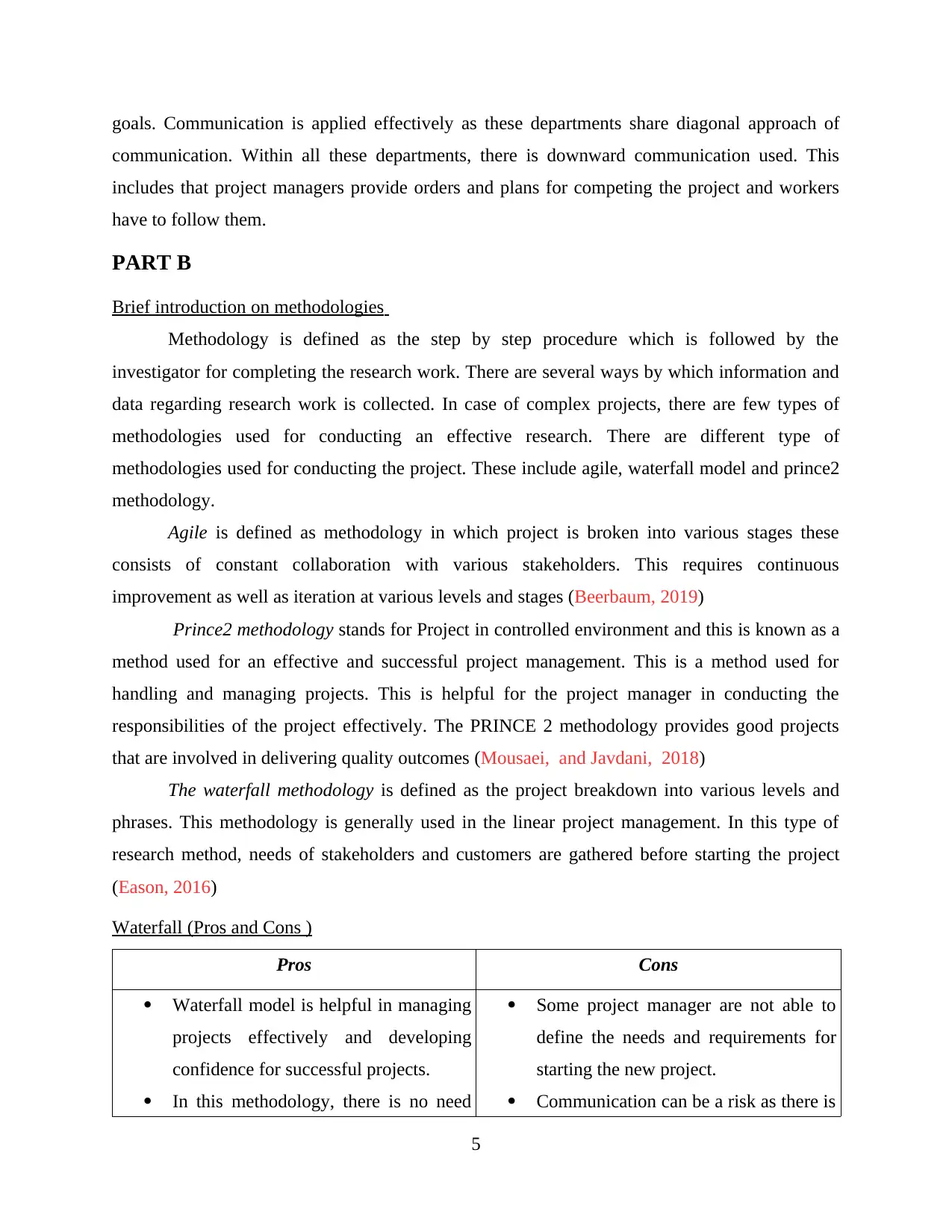
goals. Communication is applied effectively as these departments share diagonal approach of
communication. Within all these departments, there is downward communication used. This
includes that project managers provide orders and plans for competing the project and workers
have to follow them.
PART B
Brief introduction on methodologies
Methodology is defined as the step by step procedure which is followed by the
investigator for completing the research work. There are several ways by which information and
data regarding research work is collected. In case of complex projects, there are few types of
methodologies used for conducting an effective research. There are different type of
methodologies used for conducting the project. These include agile, waterfall model and prince2
methodology.
Agile is defined as methodology in which project is broken into various stages these
consists of constant collaboration with various stakeholders. This requires continuous
improvement as well as iteration at various levels and stages (Beerbaum, 2019)
Prince2 methodology stands for Project in controlled environment and this is known as a
method used for an effective and successful project management. This is a method used for
handling and managing projects. This is helpful for the project manager in conducting the
responsibilities of the project effectively. The PRINCE 2 methodology provides good projects
that are involved in delivering quality outcomes (Mousaei, and Javdani, 2018)
The waterfall methodology is defined as the project breakdown into various levels and
phrases. This methodology is generally used in the linear project management. In this type of
research method, needs of stakeholders and customers are gathered before starting the project
(Eason, 2016)
Waterfall (Pros and Cons )
Pros Cons
Waterfall model is helpful in managing
projects effectively and developing
confidence for successful projects.
In this methodology, there is no need
Some project manager are not able to
define the needs and requirements for
starting the new project.
Communication can be a risk as there is
5
communication. Within all these departments, there is downward communication used. This
includes that project managers provide orders and plans for competing the project and workers
have to follow them.
PART B
Brief introduction on methodologies
Methodology is defined as the step by step procedure which is followed by the
investigator for completing the research work. There are several ways by which information and
data regarding research work is collected. In case of complex projects, there are few types of
methodologies used for conducting an effective research. There are different type of
methodologies used for conducting the project. These include agile, waterfall model and prince2
methodology.
Agile is defined as methodology in which project is broken into various stages these
consists of constant collaboration with various stakeholders. This requires continuous
improvement as well as iteration at various levels and stages (Beerbaum, 2019)
Prince2 methodology stands for Project in controlled environment and this is known as a
method used for an effective and successful project management. This is a method used for
handling and managing projects. This is helpful for the project manager in conducting the
responsibilities of the project effectively. The PRINCE 2 methodology provides good projects
that are involved in delivering quality outcomes (Mousaei, and Javdani, 2018)
The waterfall methodology is defined as the project breakdown into various levels and
phrases. This methodology is generally used in the linear project management. In this type of
research method, needs of stakeholders and customers are gathered before starting the project
(Eason, 2016)
Waterfall (Pros and Cons )
Pros Cons
Waterfall model is helpful in managing
projects effectively and developing
confidence for successful projects.
In this methodology, there is no need
Some project manager are not able to
define the needs and requirements for
starting the new project.
Communication can be a risk as there is
5
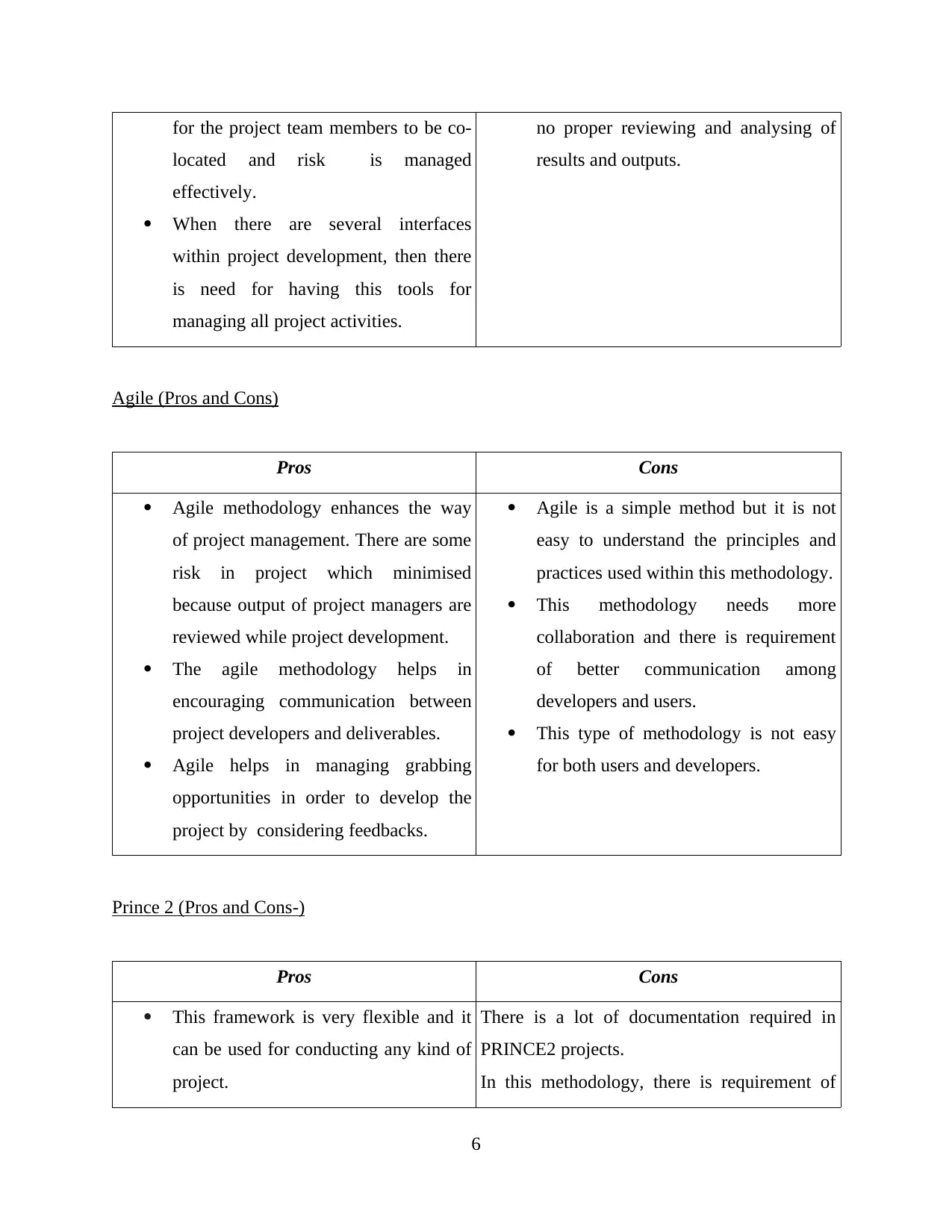
for the project team members to be co-
located and risk is managed
effectively.
When there are several interfaces
within project development, then there
is need for having this tools for
managing all project activities.
no proper reviewing and analysing of
results and outputs.
Agile (Pros and Cons)
Pros Cons
Agile methodology enhances the way
of project management. There are some
risk in project which minimised
because output of project managers are
reviewed while project development.
The agile methodology helps in
encouraging communication between
project developers and deliverables.
Agile helps in managing grabbing
opportunities in order to develop the
project by considering feedbacks.
Agile is a simple method but it is not
easy to understand the principles and
practices used within this methodology.
This methodology needs more
collaboration and there is requirement
of better communication among
developers and users.
This type of methodology is not easy
for both users and developers.
Prince 2 (Pros and Cons-)
Pros Cons
This framework is very flexible and it
can be used for conducting any kind of
project.
There is a lot of documentation required in
PRINCE2 projects.
In this methodology, there is requirement of
6
located and risk is managed
effectively.
When there are several interfaces
within project development, then there
is need for having this tools for
managing all project activities.
no proper reviewing and analysing of
results and outputs.
Agile (Pros and Cons)
Pros Cons
Agile methodology enhances the way
of project management. There are some
risk in project which minimised
because output of project managers are
reviewed while project development.
The agile methodology helps in
encouraging communication between
project developers and deliverables.
Agile helps in managing grabbing
opportunities in order to develop the
project by considering feedbacks.
Agile is a simple method but it is not
easy to understand the principles and
practices used within this methodology.
This methodology needs more
collaboration and there is requirement
of better communication among
developers and users.
This type of methodology is not easy
for both users and developers.
Prince 2 (Pros and Cons-)
Pros Cons
This framework is very flexible and it
can be used for conducting any kind of
project.
There is a lot of documentation required in
PRINCE2 projects.
In this methodology, there is requirement of
6
⊘ This is a preview!⊘
Do you want full access?
Subscribe today to unlock all pages.

Trusted by 1+ million students worldwide
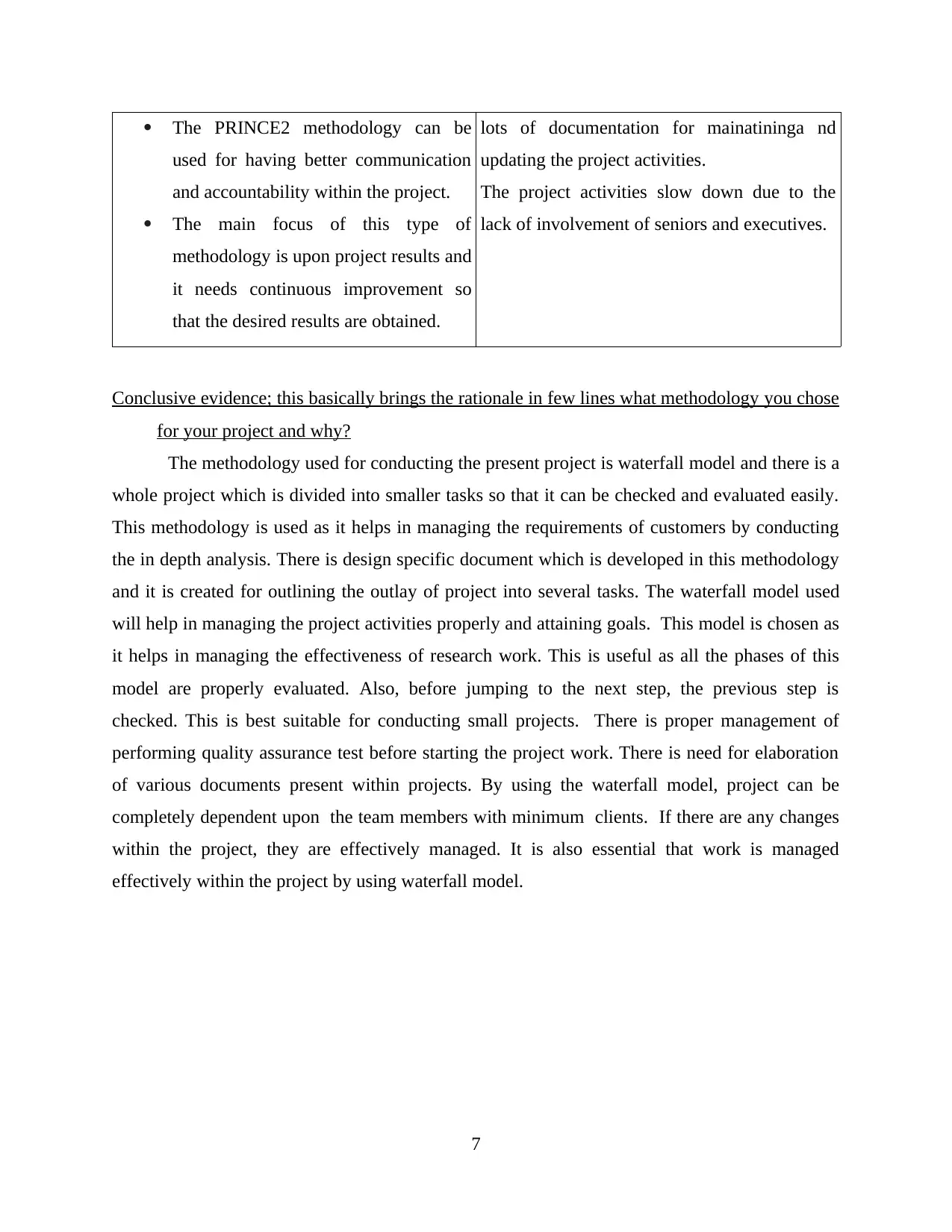
The PRINCE2 methodology can be
used for having better communication
and accountability within the project.
The main focus of this type of
methodology is upon project results and
it needs continuous improvement so
that the desired results are obtained.
lots of documentation for mainatininga nd
updating the project activities.
The project activities slow down due to the
lack of involvement of seniors and executives.
Conclusive evidence; this basically brings the rationale in few lines what methodology you chose
for your project and why?
The methodology used for conducting the present project is waterfall model and there is a
whole project which is divided into smaller tasks so that it can be checked and evaluated easily.
This methodology is used as it helps in managing the requirements of customers by conducting
the in depth analysis. There is design specific document which is developed in this methodology
and it is created for outlining the outlay of project into several tasks. The waterfall model used
will help in managing the project activities properly and attaining goals. This model is chosen as
it helps in managing the effectiveness of research work. This is useful as all the phases of this
model are properly evaluated. Also, before jumping to the next step, the previous step is
checked. This is best suitable for conducting small projects. There is proper management of
performing quality assurance test before starting the project work. There is need for elaboration
of various documents present within projects. By using the waterfall model, project can be
completely dependent upon the team members with minimum clients. If there are any changes
within the project, they are effectively managed. It is also essential that work is managed
effectively within the project by using waterfall model.
7
used for having better communication
and accountability within the project.
The main focus of this type of
methodology is upon project results and
it needs continuous improvement so
that the desired results are obtained.
lots of documentation for mainatininga nd
updating the project activities.
The project activities slow down due to the
lack of involvement of seniors and executives.
Conclusive evidence; this basically brings the rationale in few lines what methodology you chose
for your project and why?
The methodology used for conducting the present project is waterfall model and there is a
whole project which is divided into smaller tasks so that it can be checked and evaluated easily.
This methodology is used as it helps in managing the requirements of customers by conducting
the in depth analysis. There is design specific document which is developed in this methodology
and it is created for outlining the outlay of project into several tasks. The waterfall model used
will help in managing the project activities properly and attaining goals. This model is chosen as
it helps in managing the effectiveness of research work. This is useful as all the phases of this
model are properly evaluated. Also, before jumping to the next step, the previous step is
checked. This is best suitable for conducting small projects. There is proper management of
performing quality assurance test before starting the project work. There is need for elaboration
of various documents present within projects. By using the waterfall model, project can be
completely dependent upon the team members with minimum clients. If there are any changes
within the project, they are effectively managed. It is also essential that work is managed
effectively within the project by using waterfall model.
7
Paraphrase This Document
Need a fresh take? Get an instant paraphrase of this document with our AI Paraphraser
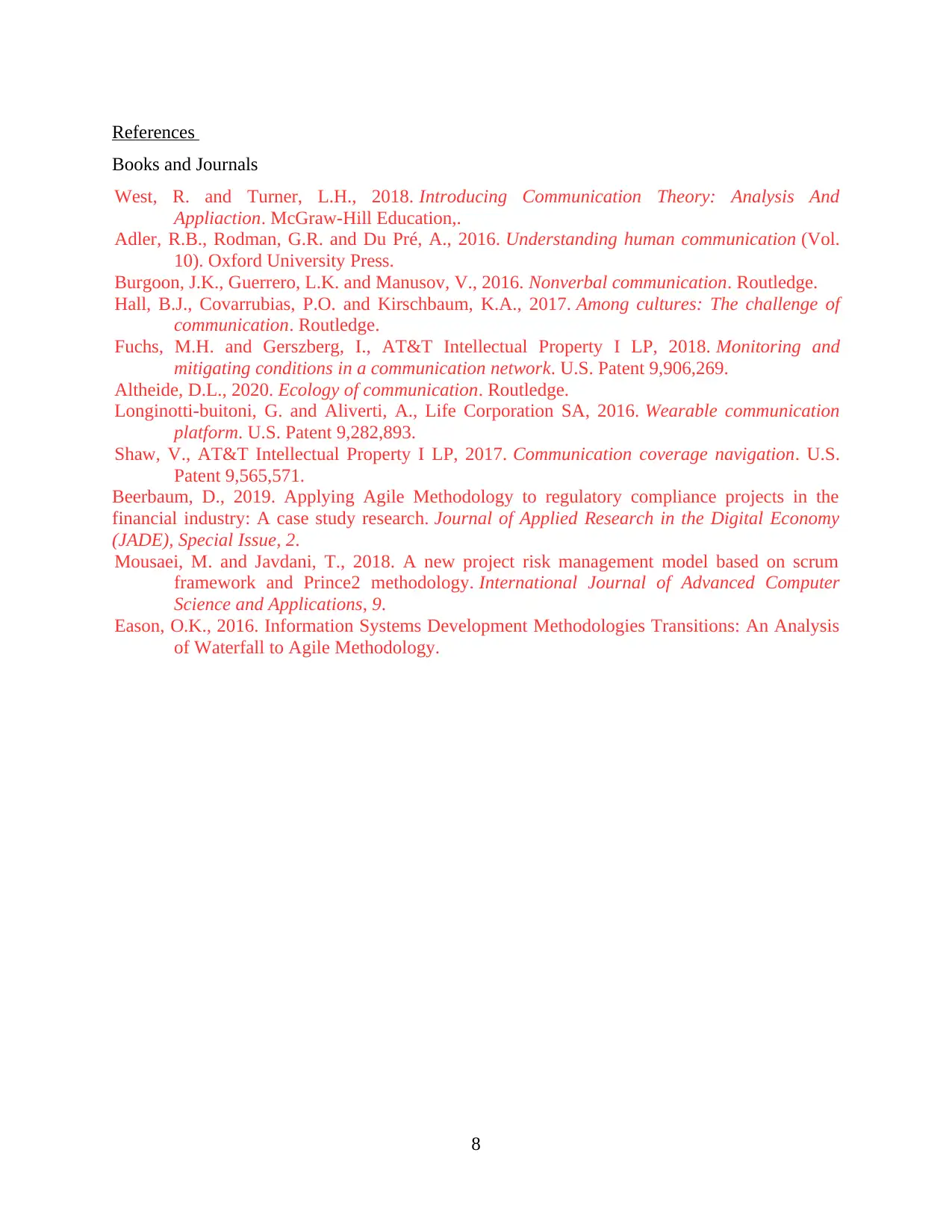
References
Books and Journals
West, R. and Turner, L.H., 2018. Introducing Communication Theory: Analysis And
Appliaction. McGraw-Hill Education,.
Adler, R.B., Rodman, G.R. and Du Pré, A., 2016. Understanding human communication (Vol.
10). Oxford University Press.
Burgoon, J.K., Guerrero, L.K. and Manusov, V., 2016. Nonverbal communication. Routledge.
Hall, B.J., Covarrubias, P.O. and Kirschbaum, K.A., 2017. Among cultures: The challenge of
communication. Routledge.
Fuchs, M.H. and Gerszberg, I., AT&T Intellectual Property I LP, 2018. Monitoring and
mitigating conditions in a communication network. U.S. Patent 9,906,269.
Altheide, D.L., 2020. Ecology of communication. Routledge.
Longinotti-buitoni, G. and Aliverti, A., Life Corporation SA, 2016. Wearable communication
platform. U.S. Patent 9,282,893.
Shaw, V., AT&T Intellectual Property I LP, 2017. Communication coverage navigation. U.S.
Patent 9,565,571.
Beerbaum, D., 2019. Applying Agile Methodology to regulatory compliance projects in the
financial industry: A case study research. Journal of Applied Research in the Digital Economy
(JADE), Special Issue, 2.
Mousaei, M. and Javdani, T., 2018. A new project risk management model based on scrum
framework and Prince2 methodology. International Journal of Advanced Computer
Science and Applications, 9.
Eason, O.K., 2016. Information Systems Development Methodologies Transitions: An Analysis
of Waterfall to Agile Methodology.
8
Books and Journals
West, R. and Turner, L.H., 2018. Introducing Communication Theory: Analysis And
Appliaction. McGraw-Hill Education,.
Adler, R.B., Rodman, G.R. and Du Pré, A., 2016. Understanding human communication (Vol.
10). Oxford University Press.
Burgoon, J.K., Guerrero, L.K. and Manusov, V., 2016. Nonverbal communication. Routledge.
Hall, B.J., Covarrubias, P.O. and Kirschbaum, K.A., 2017. Among cultures: The challenge of
communication. Routledge.
Fuchs, M.H. and Gerszberg, I., AT&T Intellectual Property I LP, 2018. Monitoring and
mitigating conditions in a communication network. U.S. Patent 9,906,269.
Altheide, D.L., 2020. Ecology of communication. Routledge.
Longinotti-buitoni, G. and Aliverti, A., Life Corporation SA, 2016. Wearable communication
platform. U.S. Patent 9,282,893.
Shaw, V., AT&T Intellectual Property I LP, 2017. Communication coverage navigation. U.S.
Patent 9,565,571.
Beerbaum, D., 2019. Applying Agile Methodology to regulatory compliance projects in the
financial industry: A case study research. Journal of Applied Research in the Digital Economy
(JADE), Special Issue, 2.
Mousaei, M. and Javdani, T., 2018. A new project risk management model based on scrum
framework and Prince2 methodology. International Journal of Advanced Computer
Science and Applications, 9.
Eason, O.K., 2016. Information Systems Development Methodologies Transitions: An Analysis
of Waterfall to Agile Methodology.
8
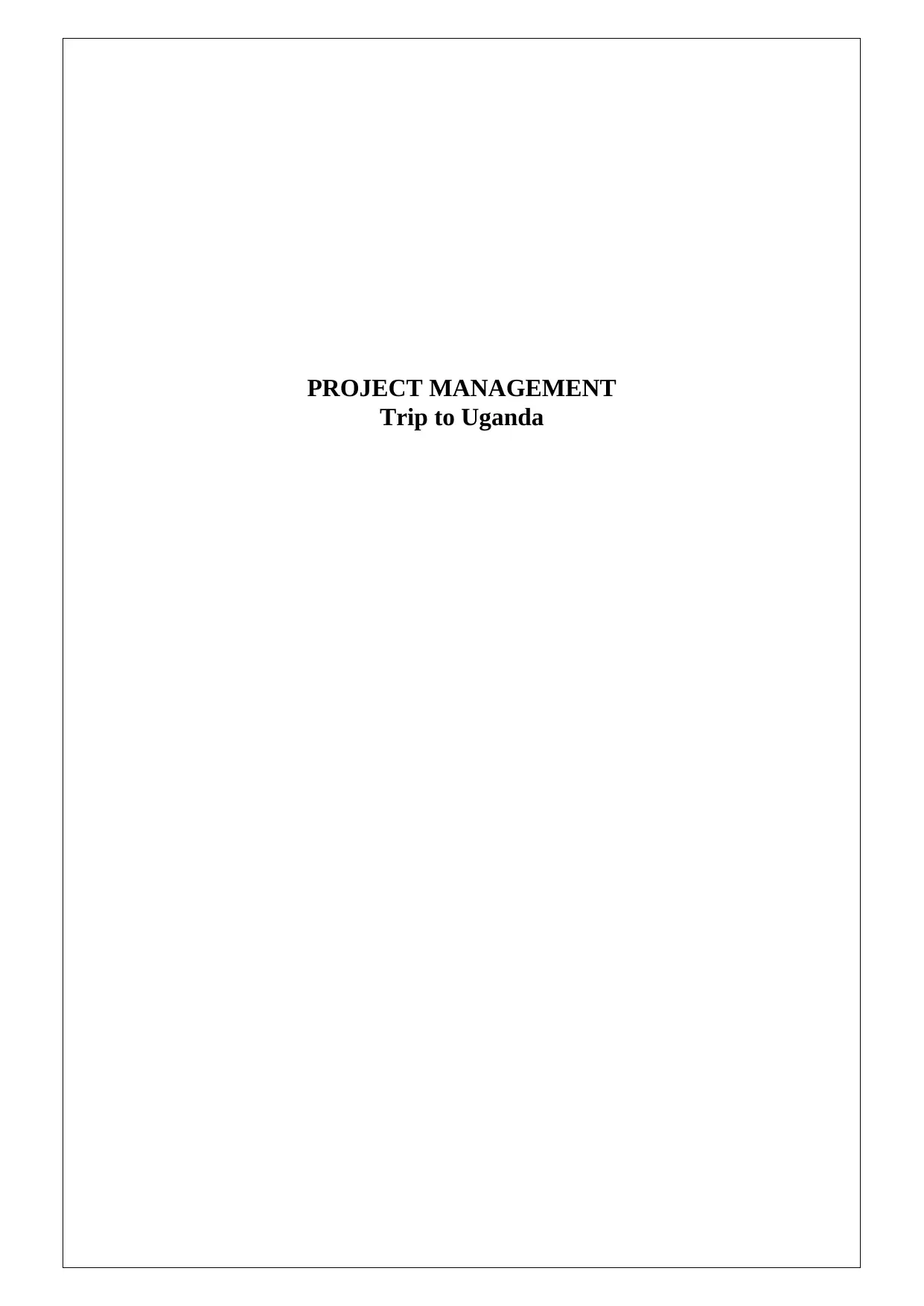
PROJECT MANAGEMENT
Trip to Uganda
Trip to Uganda
⊘ This is a preview!⊘
Do you want full access?
Subscribe today to unlock all pages.

Trusted by 1+ million students worldwide
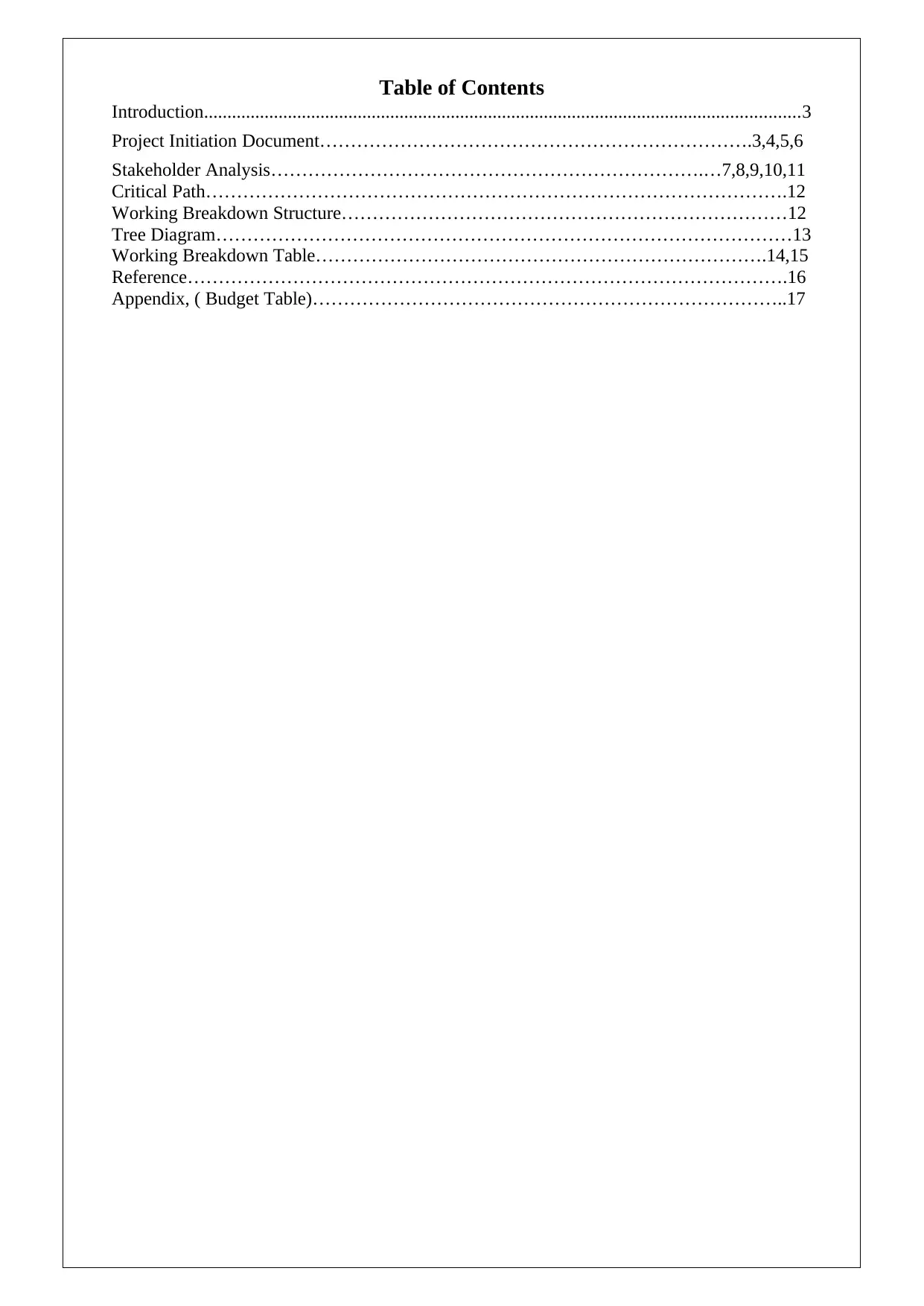
Table of Contents
Introduction................................................................................................................................3
Project Initiation Document…………………………………………………………….3,4,5,6
Stakeholder Analysis…………………………………………………………….…7,8,9,10,11
Critical Path………………………………………………………………………………….12
Working Breakdown Structure………………………………………………………………12
Tree Diagram…………………………………………………………………………………13
Working Breakdown Table……………………………………………………………….14,15
Reference…………………………………………………………………………………….16
Appendix, ( Budget Table)…………………………………………………………………..17
Introduction................................................................................................................................3
Project Initiation Document…………………………………………………………….3,4,5,6
Stakeholder Analysis…………………………………………………………….…7,8,9,10,11
Critical Path………………………………………………………………………………….12
Working Breakdown Structure………………………………………………………………12
Tree Diagram…………………………………………………………………………………13
Working Breakdown Table……………………………………………………………….14,15
Reference…………………………………………………………………………………….16
Appendix, ( Budget Table)…………………………………………………………………..17
Paraphrase This Document
Need a fresh take? Get an instant paraphrase of this document with our AI Paraphraser
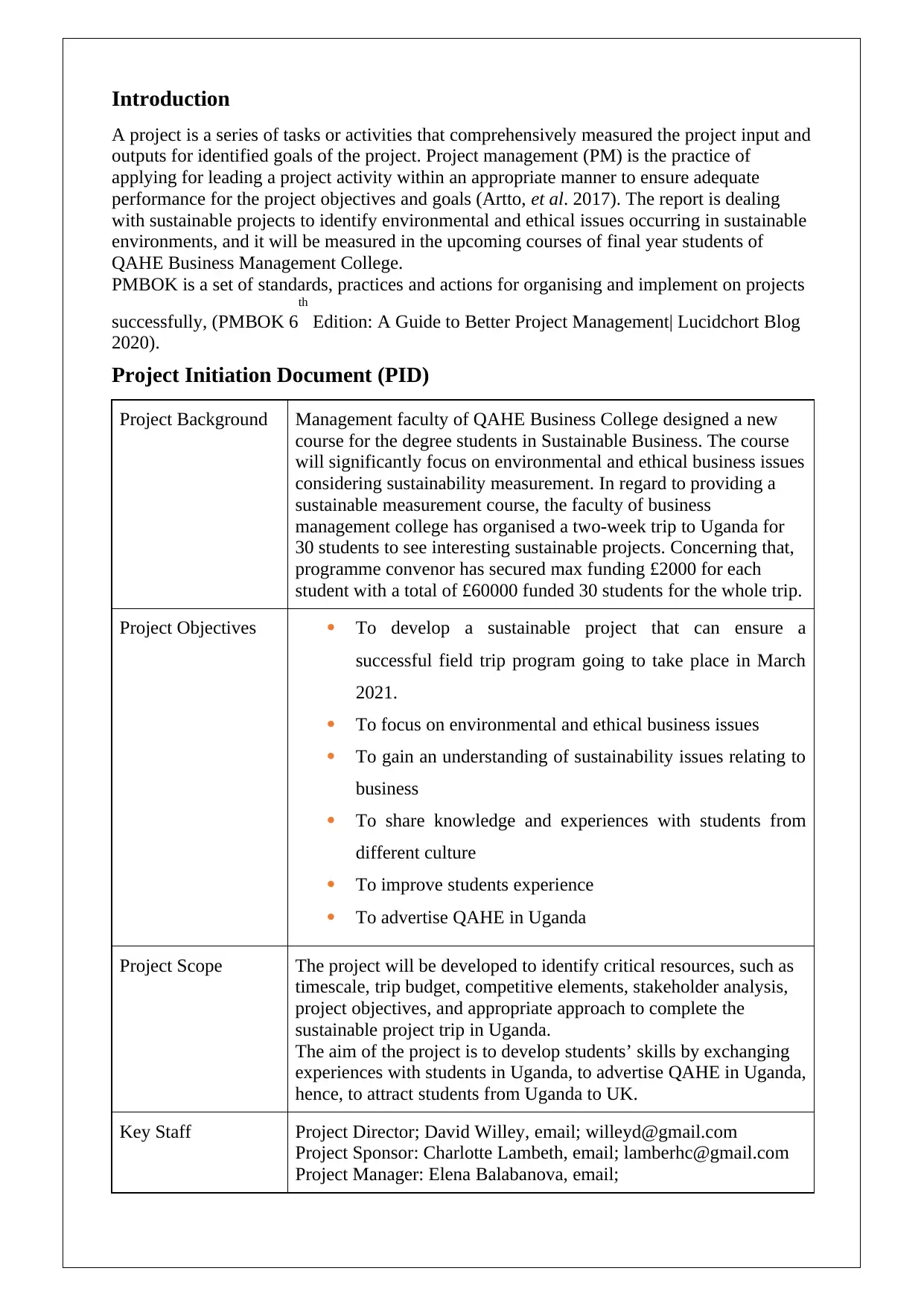
Introduction
A project is a series of tasks or activities that comprehensively measured the project input and
outputs for identified goals of the project. Project management (PM) is the practice of
applying for leading a project activity within an appropriate manner to ensure adequate
performance for the project objectives and goals (Artto, et al. 2017). The report is dealing
with sustainable projects to identify environmental and ethical issues occurring in sustainable
environments, and it will be measured in the upcoming courses of final year students of
QAHE Business Management College.
PMBOK is a set of standards, practices and actions for organising and implement on projects
successfully, (PMBOK 6
th
Edition: A Guide to Better Project Management| Lucidchort Blog
2020).
Project Initiation Document (PID)
Project Background Management faculty of QAHE Business College designed a new
course for the degree students in Sustainable Business. The course
will significantly focus on environmental and ethical business issues
considering sustainability measurement. In regard to providing a
sustainable measurement course, the faculty of business
management college has organised a two-week trip to Uganda for
30 students to see interesting sustainable projects. Concerning that,
programme convenor has secured max funding £2000 for each
student with a total of £60000 funded 30 students for the whole trip.
Project Objectives To develop a sustainable project that can ensure a
successful field trip program going to take place in March
2021.
To focus on environmental and ethical business issues
To gain an understanding of sustainability issues relating to
business
To share knowledge and experiences with students from
different culture
To improve students experience
To advertise QAHE in Uganda
Project Scope The project will be developed to identify critical resources, such as
timescale, trip budget, competitive elements, stakeholder analysis,
project objectives, and appropriate approach to complete the
sustainable project trip in Uganda.
The aim of the project is to develop students’ skills by exchanging
experiences with students in Uganda, to advertise QAHE in Uganda,
hence, to attract students from Uganda to UK.
Key Staff Project Director; David Willey, email; willeyd@gmail.com
Project Sponsor: Charlotte Lambeth, email; lamberhc@gmail.com
Project Manager: Elena Balabanova, email;
A project is a series of tasks or activities that comprehensively measured the project input and
outputs for identified goals of the project. Project management (PM) is the practice of
applying for leading a project activity within an appropriate manner to ensure adequate
performance for the project objectives and goals (Artto, et al. 2017). The report is dealing
with sustainable projects to identify environmental and ethical issues occurring in sustainable
environments, and it will be measured in the upcoming courses of final year students of
QAHE Business Management College.
PMBOK is a set of standards, practices and actions for organising and implement on projects
successfully, (PMBOK 6
th
Edition: A Guide to Better Project Management| Lucidchort Blog
2020).
Project Initiation Document (PID)
Project Background Management faculty of QAHE Business College designed a new
course for the degree students in Sustainable Business. The course
will significantly focus on environmental and ethical business issues
considering sustainability measurement. In regard to providing a
sustainable measurement course, the faculty of business
management college has organised a two-week trip to Uganda for
30 students to see interesting sustainable projects. Concerning that,
programme convenor has secured max funding £2000 for each
student with a total of £60000 funded 30 students for the whole trip.
Project Objectives To develop a sustainable project that can ensure a
successful field trip program going to take place in March
2021.
To focus on environmental and ethical business issues
To gain an understanding of sustainability issues relating to
business
To share knowledge and experiences with students from
different culture
To improve students experience
To advertise QAHE in Uganda
Project Scope The project will be developed to identify critical resources, such as
timescale, trip budget, competitive elements, stakeholder analysis,
project objectives, and appropriate approach to complete the
sustainable project trip in Uganda.
The aim of the project is to develop students’ skills by exchanging
experiences with students in Uganda, to advertise QAHE in Uganda,
hence, to attract students from Uganda to UK.
Key Staff Project Director; David Willey, email; willeyd@gmail.com
Project Sponsor: Charlotte Lambeth, email; lamberhc@gmail.com
Project Manager: Elena Balabanova, email;
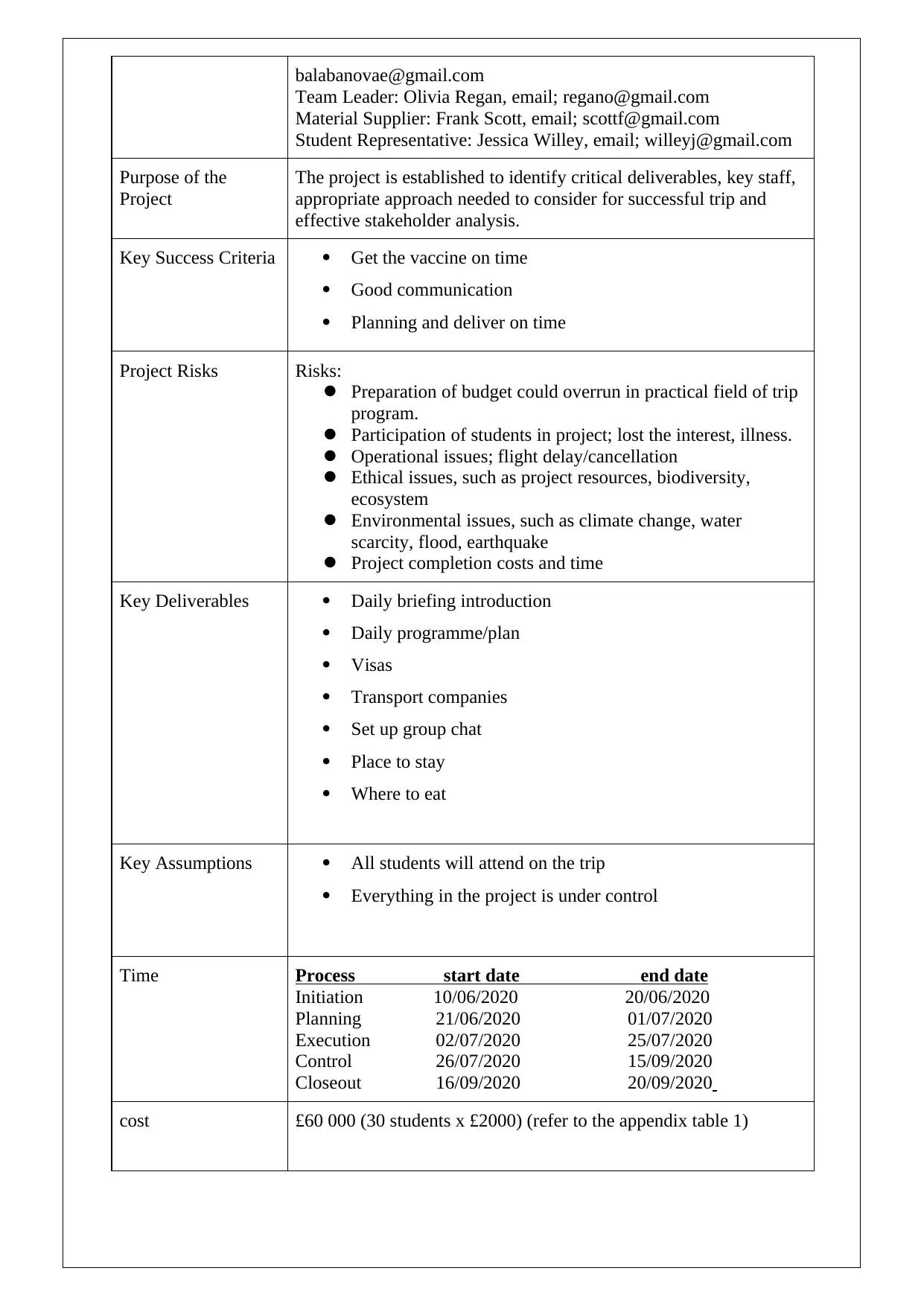
balabanovae@gmail.com
Team Leader: Olivia Regan, email; regano@gmail.com
Material Supplier: Frank Scott, email; scottf@gmail.com
Student Representative: Jessica Willey, email; willeyj@gmail.com
Purpose of the
Project
The project is established to identify critical deliverables, key staff,
appropriate approach needed to consider for successful trip and
effective stakeholder analysis.
Key Success Criteria Get the vaccine on time
Good communication
Planning and deliver on time
Project Risks Risks:
Preparation of budget could overrun in practical field of trip
program.
Participation of students in project; lost the interest, illness.
Operational issues; flight delay/cancellation
Ethical issues, such as project resources, biodiversity,
ecosystem
Environmental issues, such as climate change, water
scarcity, flood, earthquake
Project completion costs and time
Key Deliverables Daily briefing introduction
Daily programme/plan
Visas
Transport companies
Set up group chat
Place to stay
Where to eat
Key Assumptions All students will attend on the trip
Everything in the project is under control
Time Process start date end date
Initiation 10/06/2020 20/06/2020
Planning 21/06/2020 01/07/2020
Execution 02/07/2020 25/07/2020
Control 26/07/2020 15/09/2020
Closeout 16/09/2020 20/09/2020
cost £60 000 (30 students x £2000) (refer to the appendix table 1)
Team Leader: Olivia Regan, email; regano@gmail.com
Material Supplier: Frank Scott, email; scottf@gmail.com
Student Representative: Jessica Willey, email; willeyj@gmail.com
Purpose of the
Project
The project is established to identify critical deliverables, key staff,
appropriate approach needed to consider for successful trip and
effective stakeholder analysis.
Key Success Criteria Get the vaccine on time
Good communication
Planning and deliver on time
Project Risks Risks:
Preparation of budget could overrun in practical field of trip
program.
Participation of students in project; lost the interest, illness.
Operational issues; flight delay/cancellation
Ethical issues, such as project resources, biodiversity,
ecosystem
Environmental issues, such as climate change, water
scarcity, flood, earthquake
Project completion costs and time
Key Deliverables Daily briefing introduction
Daily programme/plan
Visas
Transport companies
Set up group chat
Place to stay
Where to eat
Key Assumptions All students will attend on the trip
Everything in the project is under control
Time Process start date end date
Initiation 10/06/2020 20/06/2020
Planning 21/06/2020 01/07/2020
Execution 02/07/2020 25/07/2020
Control 26/07/2020 15/09/2020
Closeout 16/09/2020 20/09/2020
cost £60 000 (30 students x £2000) (refer to the appendix table 1)
⊘ This is a preview!⊘
Do you want full access?
Subscribe today to unlock all pages.

Trusted by 1+ million students worldwide
1 out of 33
Related Documents
Your All-in-One AI-Powered Toolkit for Academic Success.
+13062052269
info@desklib.com
Available 24*7 on WhatsApp / Email
![[object Object]](/_next/static/media/star-bottom.7253800d.svg)
Unlock your academic potential
Copyright © 2020–2025 A2Z Services. All Rights Reserved. Developed and managed by ZUCOL.





